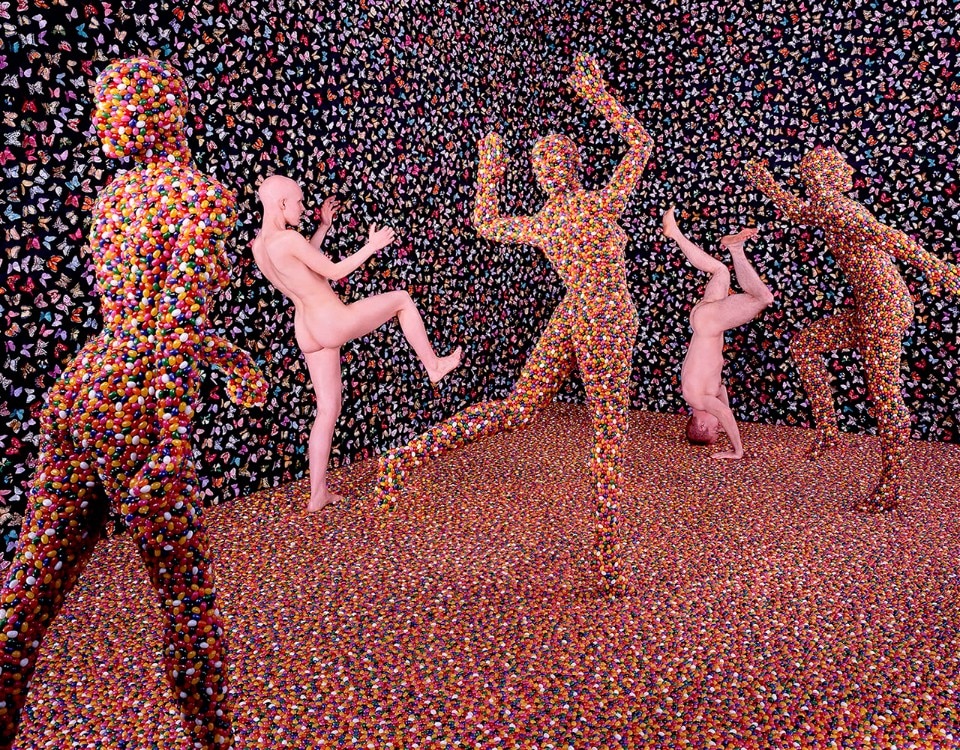Blue owls, radioactive green cats, twisted snakes and rabbits on a floor of eggshells. “Is this not the life that surrounds us? This is the human condition. In the moment of birth, reality is a shock, it is a new place, full of anxiety and fear. The aim of art is to reduce that fear”. In her over 60 years of career, Sandy Skoglund responds to the worries of contemporary life with a fantastical imagination which recalls the grotesque bestiary of Hieronymus Bosch and the parallel dimensions of David Lynch. For the first time in Italy, CAMERA. The Italian Centre for Photography is dedicating an anthological exhibition to the artist: “Sandy Skoglund. Visioni Ibride [Hybrid Visions]”, until 24 March. One hundred works including photographs (together with Jeff Wall and Cindy Sherman, Skoglund is the creator of staged photography), installations and sculptures from her studio and from Italian and foreign private collections, some pieces dating back to her artistic debut in the 1970s. Born in 1946 in Weymouth, Massachusetts, after having studied directing, engraving and graphics, she received her Master of Arts in 1971 and Master of Fine Arts in 1972. She moved to New York, where she began working as a conceptual artist, focusing on repetitive and process-oriented artistic output, over the years approaching photography and scenographic reconstruction. Slim, minute and extremely composed, the American artist wanders the inauguration of the Turin exhibition, curated by Germano Celant, pointing out pieces and explaining her latest and never-before-exhibited work, Winter. Together with Fresh Hybrid, Winter is the second work in the cycle The Project of the Four Seasons. You said that it took you ten years to make it. “I took the photograph on 22 December, just a couple of days before Christmas”, says Sandy Skoglund.
Was it a long winter?
I never imagined it would take ten years, but I had a number of periods of emotional blockage, the first being the search for material to make snowflakes. When I work, my first question, once the theme has been chosen, concerns the focus and the main idea. With the theme of winter, i imagined snowflakes. Initially, I made them from clay, because I have experience with ceramics, and I liked the idea of fragility. I worked for two years on these, and then hated them. I experimented with materials. In the end I cut them digitally. In a certain sense, Winter is a completely digital work, but at the same time it exists physically.

 View gallery
View gallery

VALUE OF WASTED TIME
Why the winter?
I have been working on artificial landscapes for years. In a certain sense, winter is a new beginning.
In all of your works and installations which you painstakingly construct, there is a significant relationship with space.
My interest lies in how we humans see conceive space. For example, a triangle and the space within the triangle, or how we can simultaneously create flat yet deep spaces. This explains the photographic aspect of my work. There is architectural construction in the installations and the three-dimensional aspects of the sculptures. With my work you always know you are inside a space, you are never in an undefined place.
There are numerous references to cinema, such as David Lynch’s universe of fear and anxiety.
Our lives are attempts to reduce that sensation of anxiety, but I think that this is the role of art. The aim of the artist is not to remain in their studio and be anxious, but to elaborate works of art which are able to express these feelings to others and help to make this type of thought go away. They must also reflect on the reason for things.
Have you also been influenced by the world you live in?
The American landscape is very different from that of Europe, it is 200 years old, and therefore there is no constant reminder of the past. Our lives have a certain freshness. Furthermore, we grow up with this theme, that anyone can have anything, or at least this is our hope. Hope is a fundamental element in psychology and philosophy. If there is no hope, what is the point of your day?


 View gallery
View gallery
In your work, the sociological aspect plays an important role.
There is also a lot of archaeology. There is extensive research and history behind my works.
Art is often a reflection of the times. Do you feel this way about your work?
I don’t know if art is a reflection of our times. But I know what my work is, it is to be the mirror, to be passive, to receive, participate as much as possible without judging.
Extensive research leads up to the final result. Nowadays, much of your research is done on the Internet, but if we all take from the same source, is the result always the same, albeit with some variation? What is your advice for young artists?To always stay still in a space. Don’t move out, remain in silence and with yourselves. There is an inner and an outer universe. I have used various processes to try and find reality. An artist must always know how to tell the truth about what they see. Of course, there are doubts, but it is necessary to separate one’s thoughts from the world. The Internet is nothing more than a place for social networks. It is easy, useful and fast, but it cannot be a substitute for real thought.
- Exhibition:
- Sandy Skoglund. Visioni Ibride
- Location:
- Camera, Turin
- Opening dates:
- Until March 24.


















